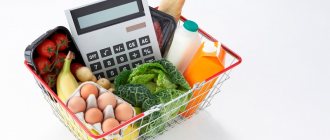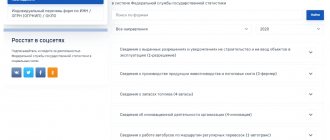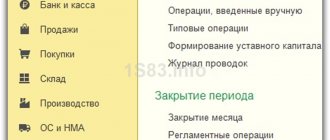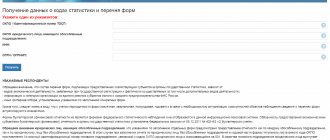The role of value added tax in the Russian Federation
Value added tax is an indirect tax of federal significance and plays a significant role in the formation of the budget of the Russian Federation. The value added tax is regulated by Chapter 21 Part 2 of the Tax Code of the Russian Federation.
The role of VAT in the state is quite high. Currently, the entire tax amount goes to the Federal Budget, which makes it possible to solve such important government tasks as:
- repayment of public debt;
- increasing pension and social benefits to citizens of the Russian Federation;
- implementation of a number of federal social programs, etc.
Algorithm of actions when calculating VAT
In order to accurately calculate VAT, you need to determine the following criteria:
| Criteria | Explanation |
| Determine tax rate | In accordance with Article 164 of the Tax Code of the Russian Federation, the following tax rates have been adopted:
|
| Determine the tax base | Initial cost of production + excise taxes |
| Calculate VAT using a specific formula | Formulas are presented in the section “Rate, formulas used for calculation” of this article |
In reality, there is nothing difficult in calculating VAT. It is enough to have specific ideas about the tax rate and tax base.
Filling out an invoice
All requirements for filling out an invoice can be found in the Tax Code, Art. 169. The document can be drawn up either electronically or on paper. In the first case, you need to take care of creating a paper copy with all the stamps and signatures, since tax inspectors require a paper document when checking.
In accordance with the requirements of the legislation of the Russian Federation, the document must include:
- information about the supplier and buyer;
- date of compilation;
- serial number;
- quantity and name of the product;
- price;
- tax rate;
- VAT amount.
If we are talking about an invoice for a transaction with foreign companies, it is also necessary to indicate the country of manufacture of the goods and the customs declaration number.
Rate, formulas used for calculation
In accordance with Article 163 of the Tax Code of the Russian Federation, the VAT tax rate will depend on the economic activity carried out by the organization:
| VAT rate | Economic activity |
| 0% | Sales within the customs zone, export of products, international transportation. |
| 10% | Sale of children's products, medical supplies, some food products, printed publications, breeding animals and birds. |
| 18% | All business activities not mentioned above. |
It is very important to correctly determine the tax rate in order to avoid problems with the tax authorities.
Entrepreneurs have to deal with two cases of VAT calculation:
- it is necessary to determine VAT on the cost of goods, works, services;
- it is necessary to allocate VAT from the existing total amount.
If VAT is required on the cost of goods, works, services, the following formulas are used:
- VAT 18%:
| VAT | = | total amount | * | 0,18 |
- VAT 10%:
| VAT | = | total amount | * | 0,10 |
For example:
ABV LLC sells products to individual entrepreneur M.M. Mokhov. in the amount of 70,000 rubles. VAT 18%. The VAT amount will be 70,000 * 0.18 = 12,600 rubles. The amount to be paid will be 70,000 + 12,600 = 82,600 rubles.
Total:
The cost of production is 70,000 rubles. VAT 18% – 12,600 rubles. Payable – 82,600 rubles.
If it is necessary to isolate VAT from an existing total amount, the following formulas are recommended for use:
- allocation of VAT 18%:
| VAT | = | total amount | / | 118 | * | 18 |
- allocation of VAT 10%:
| VAT | = | total amount | / | 110 | * | 10 |
- 0% VAT is not allocated.
For example:
ABC LLC sells fishing nets at a price of 600 rubles per piece. including VAT 18%. IP Mokhov M.M. ordered 25 pcs. First you need to determine the total amount: 600 * 25 = 15,000 rubles. VAT will be: 15,000 / 118 * 18 = 2,288 rubles. Amount without VAT: 15,000 – 2,288 = 12,712 rubles.
Total:
The amount excluding VAT is 12,712 rubles. VAT 18% – 2288 rubles. The total amount to be paid is 15,000 rubles.
Changes in the list of products and children's goods in 2019-2020
From 07/01/2020, the import and sale of some milk-containing products with milk fat substitute will be taxed at a rate of 10%. Thus, the list of food products on the sale of which a tax must be paid at a rate of 10% includes the following milk-containing products with a milk fat substitute:
- drinks, cocktails and jelly;
- jellies, sauces, creams, puddings, mousses, pastes and soufflés;
- condensed canned food.
In addition, sales of milk-containing ice cream should also be taxed at a reduced rate. These changes are provided for by Government Decree No. 250 dated 03/09/2020.
In 2021, changes to Resolution No. 908, containing a list of products and goods for children subject to VAT of 10 percent, were introduced by resolutions of the Government of the Russian Federation:
- dated 01/30/2019 No. 58 (effective from 02/09/2019) - they added fish fillets and other fish meat (including minced meat) in fresh and chilled form to the list of products;
- dated 12/06/2018 No. 1487 (effective from 04/01/2019) - the list of amendments here is quite wide.
What exactly does the update in the list of goods with 10 percent VAT apply to? What specific products and children's products does it apply to? The full list of changes is as follows:
- in terms of food products: for live livestock and poultry, an indication has been added that the benefits do not include their breeding species;
- for fats and oils of animal origin, as well as for palm, coconut, palm kernel babassu and other vegetable oils, the marking on their intended use for food purposes is excluded;
- for soups and broths prepared with meat, it is clarified that they do not include not only vegetable ones, but also others that do not contain meat;
- ornamental rodents and reptiles have been added to the number of animals excluded from the list of consumers of boiled feed;
- it is clarified that other types of edible ice are also excluded from the list of benefits;
- the list includes hatching eggs, with the exception of breeding eggs;
- the composition of products for animal feeding has been detailed, and ornamental rodents and reptiles have been added to the list of those excluded from the list of consumers;
- The codes for onions and bulbous vegetables, as well as for other vegetables, have been clarified;
- the list of preferential knitwear and clothing products has been significantly expanded by adding the definition “similar” to the text of the description;
Thus, due to the changes in 2021, the list of goods with a VAT rate of 10 percent has expanded.
What do you need to know to calculate VAT?
To calculate VAT, entrepreneurs need to decide on the indicators used to carry out this calculation:
| Index | A comment |
| The tax base | The tax base for calculating VAT will be considered (Article 153 of the Tax Code of the Russian Federation): · the volume of proceeds received from the sale of goods, services, works, property rights; · the amount of proceeds received under the agency agreement; · volume of funds received from the sale of imported goods, etc. |
| Tax rate | The tax rate is determined by Article 164 of the Tax Code of the Russian Federation and can be equal to 0%, 10%, 18%. |
Don’t forget to get statements from all your banks
There are spare (reserve) current accounts, in case one bank gets sick, you can try to transfer funds to another bank in time (“transfer of your own funds”).
Yes, and this happens - after all (as it turns out in fact) the fact that you use a current account in some bank and store some money there - it is you who are at risk, not the bank. These are today's realities.
Don’t forget to download the statements there, because the commission is most likely being charged, i.e. there is movement.
How to determine the appropriate rate?
To determine the tax rate, you must be guided by Article 164 of the Tax Code of the Russian Federation:
| Tax rate | Type of economic activity |
| 0% | · export of goods; · international transportation of goods; · work related to pipeline transport of oil and petroleum products; · organization of pipeline transportation of natural gas; · export of electricity; · transshipment and storage of export goods in sea and river ports; · services for processing goods in customs zones; · goods, works, services in the field of space activities; · rail transportation of passengers and luggage on commuter and long-distance trains; · extraction of precious metals from scrap and waste; · goods, works, services for foreign diplomats. |
| 10% | · sales of food products; · sales of children's goods; · sales of printed products; · sale of medical products; · domestic air transportation. |
| 18% | All other cases not mentioned earlier. |
As is already clear, the tax rate depends on the type of economic activity. There are situations when an organization can simultaneously perform several operations related to different tax rates. In this case, it is necessary to make calculations very carefully using VAT calculation formulas.
When can 10% VAT be applied? General list of goods
Currently, three types of VAT rates are applied in the Russian Federation. As a rule, for transactions related to sales within the country, it is more profitable for entrepreneurs to use a preferential VAT rate of 10%. The Tax Code of the Russian Federation specifies a taxable list of products at a VAT rate of 10%.
To support the development of entrepreneurship at the state level, a preferential VAT rate of 10% was created and a list of transactions falling under this special regulation was compiled. Many businessmen have always been and are concerned about the question of whether the VAT rate of 10% will be changed. We list which goods are subject to a VAT rate of 10%:
- Animals, poultry in live weight, meat products, eggs, vegetable oils, sugar, dairy products, flour and flour products and other food products.
- Clothing, bedding, baby hygiene products, school supplies and other products for children.
- Medicinal products (medicines, including pharmaceuticals used in animal testing).
- Books, periodicals.
- Breeding cattle.
It is interesting that in some states the rates of indirect taxes within the same product group differ. For example, in the USA there are different tax rates for the sale of toys.
Are there cases when a list of goods cannot be subject to the 10% VAT rate? Yes. For example, a valid registration certificate is required to apply a 10 percent VAT rate to a list of goods. However, there is always a chance to confirm your ability to apply the VAT rate of 10%, and how can you prove the reduced tax scale? It will be necessary to ensure that the agent did everything possible to ensure timely registration, but it was postponed due to the executive authority.
How to calculate VAT on the amount?
There are situations when payment documents and contracts do not contain the VAT amount:
- advance payment against future delivery of goods;
- carrying out tax calculations by a tax agent;
- VAT is included in the price of the goods, but is not allocated.
In these cases, it is necessary to allocate VAT using the following formula (depending on the tax rate):
- allocation of VAT 18%:
| VAT | = | total amount | / | 118 | * | 18 |
- allocation of VAT 10%:
| VAT | = | total amount | / | 110 | * | 10 |
Suppliers count 60
60.01 D remainder = 0! 60.02 K remainder = 0 !
76.VA D balance = 0 76.VA K = 60.02*18/118 - provided that all suppliers have issued an account for the advance. But in reality this doesn’t happen: 76.VA loan
It is useful to view the status of documents - Invoices from suppliers
60 - see Purchases - Invoices from suppliers? status = Not Received!
19.3 19.4 VAT from suppliers
19.3 balance Credit = Debit = 0 - everything should be closed without balances, all debit turnovers within the quarter are equal to credit ones.
How to calculate VAT for a quarter/half year/year?
The tax period for paying VAT is a quarter (Article 163 of the Tax Code of the Russian Federation). The declaration must be submitted to the tax authorities within the following deadlines:
| Quarter | Deadline for submitting the declaration |
| 1st quarter | Until April 25 |
| 2nd quarter | Until July 25 |
| 3rd quarter | Until October 25 |
| 4th quarter | Until January 25 |
VAT is paid in equal installments before the 20th day of each month of the next quarter:
| Quarter | VAT payment deadlines |
| 1st quarter | Until April 25, until May 25, until June 25 |
| 2nd quarter | Until July 25, until August 25, until September 25 |
| 3rd quarter | Until October 25, until November 25, until December 25 |
| 4th quarter | Until January 25, until February 25, until March 25 |
To correctly calculate VAT for the quarter, you must:
- Determine the tax base - the sum of all income received by the taxpayer during the tax period (Article 153 of the Tax Code of the Russian Federation):
| The tax base | = | Income received from sales | + | Advances |
- After determining the tax base, it is necessary to calculate VAT:
| VAT | = | The tax base | * | 0,18 (0,10) |
If an organization was engaged in the sale of goods, works, or services subject to different VAT tax rates, it is necessary to make calculations separately for each category. Read also the article: → “Procedure and deadline for paying VAT”
- After calculating VAT, it is necessary to make a tax deduction (Article 171 of the Tax Code of the Russian Federation).
A deduction is the amount of VAT that an organization has already paid to suppliers of goods, works, and services.
- Calculate VAT payable to the budget:
| VAT payable to the budget | = | VAT | – | Deduction |
In order for the entrepreneur to be able to confirm the accuracy of the information, it is necessary to fill out the following documents:
- invoice;
- Sales book;
- Book of purchases.
In the event of an inspection by tax authorities, this documentation must be provided to the inspectors. Organizations are required to make such VAT calculations quarterly. The law does not prohibit the transfer of deductions to subsequent quarters within three years, but the calculated VAT must be paid within strictly defined periods.
Questions and answers
Question No. 1. Our company has purchased goods for subsequent sale, but has not yet been sold. Should we take VAT into account?
Answer: Of course they should. Input VAT is then used as a deduction.
Question No. 2. We plan to use cargo transportation services. Can we deduct VAT in the future?
Answer: If you have an invoice, you can count on the right to deduct VAT.
Question No. 3. The organization shipped the goods, but did not receive payment. When is VAT required?
Answer: VAT must be calculated immediately as soon as the goods are disposed of, i.e. from the moment of shipment.
Question No. 4. HOA "Trudovik" carries out maintenance of its home on its own. What is subject to VAT calculation in this case?
Answer: In this case, VAT is not subject to payment for accommodation in the apartment. And payments for all services (cleaning of the territory, security, utilities) are subject to VAT.
How to calculate VAT correctly?
Example:
LLC "ABV" for the 1st quarter of 2021 sold:
- chairs for the consulate 600 rub./piece. - 100 pieces.;
- buckwheat 50 rub./kg. – 200 kg;
- pasta 40 rub./kg. – 300 kg;
- children's beds 2000 rub./pcs. – 25 pcs.;
- building blocks 800 rub./m3 – 100 m3;
- cement 50 rub./mesh. – 100 mesh.
For the 1st quarter, the amount of VAT paid to suppliers amounted to 16,150 rubles.
It is necessary to determine the tax base:
VAT 0%: chairs for the consulate 600 * 100 = 60,000 rubles. VAT 10%: buckwheat, pasta, children's beds (50 * 200) + (40 * 300) + (2000 * 25) = 72,000 rubles. VAT 18%: building blocks, cement (800 * 100) + (50 * 100) = 85,000 rubles.
After determining the tax base, it is necessary to calculate VAT:
(72000 * 0.10) + (85000 * 0.18) = 22500 rubles. The amount of VAT subject to payment to the budget, taking into account the deduction of 22500 – 16150 = 6350 rubles.
Fool's method
There is a cool method when, without understanding anything about the algorithms for calculating VAT payable, we focus only on the fact that 1C knows what it is doing.
We take it as a fact that, for example, “Express check of accounting (VAT)” checks everything correctly.
Let’s say our 62.2/6 does not beat 76AB (2019Q2), but there are suspicions that everything was done correctly (during the transition to 20% VAT). Those. "Express VAT check" shows that everything is Gut!
We do this:
We remove one line from the formation of the purchase book and see that “Express VAT check” noticed and began to swear. Aha - that means everything is correct in the document for creating the purchase book .
Next, we’ll post one invoice for the advance in the same way and see what “Express VAT Check” noticed and started swearing. The conclusion and invoices for advance payments are also correct.
It's cool isn't it.
And so on …
VAT innovations in 2017
There are no global changes in relation to VAT in 2021, but a number of innovations are still worth noting:
| Innovation | Explanation | Normative act |
| VAT 15.25% for foreign companies providing Internet services | This innovation will apply to almost all electronic service providers not registered in the Russian Federation. | Federal Law of July 3, 2016 No. 244-FZ |
| VAT 10% for publications with advertising volume no more than 45% | Previously, advertising volume was limited to 40%. | Federal Law of November 30, 2016 No. 408-FZ |
| Even more transactions are subject to 10% VAT. | Operations related to the issuance of guarantees and guarantees to non-banking organizations. | Federal Law of November 30, 2016 No. 408-FZ |
VAT calculation errors
Incorrect calculation of VAT entails the imposition of penalties on the organization. But often erroneous calculations still occur:
| Error | A comment |
| Advance payments are not included in the tax base | In accordance with Article 154 of the Tax Code of the Russian Federation, advance payments are subject to VAT calculation. |
| Accepted for accounting for input VAT in case of an incorrectly drawn up invoice | This error may cause suspicion and mistrust of the tax authorities. Incoming invoices must be closely monitored. |
| There is no separate accounting | If an organization refuses to keep separate records of transactions subject to VAT and non-VAT, VAT will not be deductible. |
| VAT refund for fines or penalties | A fine or penalty is not considered to be goods, work, or services, and therefore VAT refunds cannot be made. |
Online VAT calculator
The VAT calculator performs tax calculations online. The calculator will help you allocate or charge VAT. The results are displayed in both numbers and words.
You can change the VAT rate, copy and save the final calculations in the calculator's memory.
|









